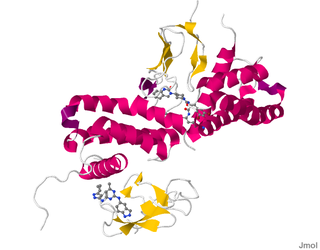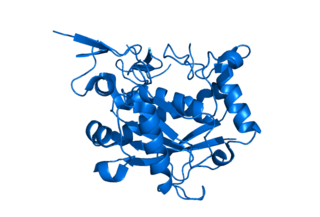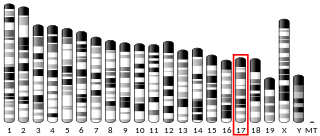
Calcitonin receptor-like (CALCRL), also known as the calcitonin receptor-like receptor (CRLR), is a human protein; it is a receptor for calcitonin gene-related peptide.

Cystatin-B is a protein that in humans is encoded by the CSTB gene.

A disintegrin and metalloproteinase with thrombospondin motifs 1 is an enzyme that in humans is encoded by the ADAMTS1 gene.

Proto-oncogene tyrosine-protein kinase FER is an enzyme that in humans is encoded by the FER gene.

Decoy receptor 1 (DCR1), also known as TRAIL receptor 3 (TRAILR3) and tumor necrosis factor receptor superfamily member 10C (TNFRSF10C), is a human cell surface receptor of the TNF-receptor superfamily.

V-type proton ATPase 116 kDa subunit a isoform 1 is an enzyme that in humans is encoded by the ATP6V0A1 gene.

Minor histocompatibility antigen H13 is a protein that in humans is encoded by the HM13 gene.

Latent-transforming growth factor beta-binding protein 3 is a protein that in humans is encoded by the LTBP3 gene.

V-type proton ATPase subunit D is an enzyme that in humans is encoded by the ATP6V1D gene.

Collapsin response mediator protein 1, encoded by the CRMP1 gene, is a human protein of the CRMP family.

Legumain is a protein that in humans is encoded by the LGMN gene.

Matrix metalloproteinase-25 is an enzyme that in humans is encoded by the MMP25 gene.

Carboxypeptidase A2 is an enzyme that in humans is encoded by the CPA2 gene.

Alpha-S1-casein is a protein that in humans is encoded by the CSN1S1 gene.

Cathepsin W is a protein that in humans is encoded by the CTSW gene.

TATA element modulatory factor is a protein that in humans is encoded by the TMF1 gene.

V-type proton ATPase subunit E 2 is an enzyme that in humans is encoded by the ATP6V1E2 gene.

Potassium channel regulator, also known as KCNRG, is a protein which in humans is encoded by theKCNRG gene.

Ryanodine receptor 3 is one of a class of ryanodine receptors and a protein that in humans is encoded by the RYR3 gene. The protein encoded by this gene is both a calcium channel and a receptor for the plant alkaloid ryanodine. RYR3 and RYR1 control the resting calcium ion concentration in skeletal muscle.

NLRP6, short for NOD-like receptor family pyrin domain containing 6, is an intracellular protein that plays a role in the immune system. It is also known as NALP6, PYPAF5, PAN3, and CLR11.4, and is one of 14 pyrin domain containing members of the NOD-like receptor family of pattern recognition receptors. As with several other NOD-like receptors, NLRP6's role in immunity is related to its ability to regulate caspase-1 and NF-κB activity.




















